 Design Resin Jewelry First published in the United States in 2021 by Stash Books, an imprint of C&T Publishing, Inc., P.O. Box 1456, Lafayette, CA 94549 Rsine, 37 Bijoux Fantaisies 2019 by Editions Huapango / Un Dimanche Aprs-Midi. This translation of Rsine, 37 Bijoux Fantaisies, first published in France, is published by arrangement with Cat on a Book Agency, France. PUBLISHER: Amy Barrett-Daffin CREATIVE DIRECTOR: Gailen Runge ACQUISITIONS EDITOR: Roxane Cerda MANAGING EDITOR: Liz Aneloski ENGLISH-LANGUAGE COVER DESIGNER AND LAYOUT ARTIST: April Mostek ENGLISH TRANSLATION: Kristy Darling Finderi PRODUCTION COORDINATOR: Zinnia Heinzmann PRODUCTION EDITOR: Jennifer Warren GRAPHIC ELEMENTS PROVIDED BY SHUTTERSTOCK.COM: LyalyaBelaya ABOUT THE AUTHORSROZEN MARTEL-GOULIBO, aka Kerrozenn, is a creative jack-of-all-trades. This polymer addict, ever eager for new techniques and new means of expression, discovered resin and its fabulous possibilities in 2013. NADIA JULLIEN, aka Nadia Her, fell into crafting at a very young age. NADIA JULLIEN, aka Nadia Her, fell into crafting at a very young age.
Design Resin Jewelry First published in the United States in 2021 by Stash Books, an imprint of C&T Publishing, Inc., P.O. Box 1456, Lafayette, CA 94549 Rsine, 37 Bijoux Fantaisies 2019 by Editions Huapango / Un Dimanche Aprs-Midi. This translation of Rsine, 37 Bijoux Fantaisies, first published in France, is published by arrangement with Cat on a Book Agency, France. PUBLISHER: Amy Barrett-Daffin CREATIVE DIRECTOR: Gailen Runge ACQUISITIONS EDITOR: Roxane Cerda MANAGING EDITOR: Liz Aneloski ENGLISH-LANGUAGE COVER DESIGNER AND LAYOUT ARTIST: April Mostek ENGLISH TRANSLATION: Kristy Darling Finderi PRODUCTION COORDINATOR: Zinnia Heinzmann PRODUCTION EDITOR: Jennifer Warren GRAPHIC ELEMENTS PROVIDED BY SHUTTERSTOCK.COM: LyalyaBelaya ABOUT THE AUTHORSROZEN MARTEL-GOULIBO, aka Kerrozenn, is a creative jack-of-all-trades. This polymer addict, ever eager for new techniques and new means of expression, discovered resin and its fabulous possibilities in 2013. NADIA JULLIEN, aka Nadia Her, fell into crafting at a very young age. NADIA JULLIEN, aka Nadia Her, fell into crafting at a very young age.
With drawing, beading, resin, etc., she has shown talent in different techniques, which she dissects and never hesitates to blend. Naturally, she began to use resin (an easy medium to blend). Her generosity led her to create a resin group on Facebook so as to share her discoveries. It was in this Facebook group that a great friendship was born between Rozen and Nadia. Their mutual passion for both resin crafts and sharing brought them together for this book. They wanted to create a resource that would be easy to understand and loaded with information and tips to answer any question you might have.
Rozen lives in the southwest of France with her two children; her husband; and her Chihuahua, Julie, whom her YouTube subscribers know very well. Nadia lives in the Val-dOise region near Paris with her three children, her husband, and numerous pets. ACKNOWLEDGMENTS We would like to thank the Socit ResinPro, which you can find at resinpro.eu, for their contribution to this books realization by providing us with all of our materials. We would also like to thank them for their trust, support, and encouragement throughout this year. We would like to thank our families for their patience and support. RESIN You will find different types of resin in craft stores. RESIN You will find different types of resin in craft stores.
In this book, we have used epoxy resin and UV resin. Please note that resins differ depending on their composition and use. UV RESIN UV resin is a single-component resin that comes in one bottle. It is used with transparent silicone molds that allow UV rays to penetrate. It is also used to thinly coat surfaces. UV resin cures in 2 or 3 minutes under a 36W UV lamp, or 10 minutes in direct sunlight.
It is ideal for jewelry making and coating small surfaces. You can color it and incorporate decorative elements to your hearts desire. As an added bonus, it can serve as a transparent glue in your jewelry making (see Ocean project). UV RESIN PROS: Convenient to use: a single component in a ready-to-use container, complete with measuring cap. Comes in several ready-made colors or transparent. Sets quickly, curing in 2 minutes under a UV lamp.
Can be used in very small quantities. Strong and durable. CONS: Expensive. Needs UV light to harden, so youll need to invest in a 36W UV lamp. Tends to yellow over time with further exposure to UV rays. Curing is inhibited if too much coloring is added and depending on the materials you have embedded.
Can be tacky to the touch. Can sometimes come loose, depending on the setting. For a nice finish, as with all resins, it should be sanded and polished. EPOXY RESIN Epoxy resin is made up of two components: the epoxy resin polymerizes with a catalyst called a hardener. The hardener is specific to each type of epoxy resin and cannot be used with another variety. The ratio of epoxy resin A to epoxy hardener B must be exact and cannot be altered.
We recommend using a precision scale in order to obtain the correct ratio. Epoxy resin, like all thermosetting resins, must not be worked at temperatures below 15C / 59F (see conditions of use sheet). In jewelry making, it is possible to make several layers or strata of resin by mixing techniques (coloring, inclusions ...). This technique involves pouring as many resin layers as you want into one mold. Be sure to wait for the previous layer to completely cure before adding the next one. VARIETIES OF EPOXY RESINCASTING (LOW-VISCOSITY) EPOXY RESIN This resin was developed to reduce the number of bubbles in your creations, thanks to three fundamental characteristics: high transparency (very water-like), low viscosity, and a longer working time than that of traditional resin.
It is ideal for making jewelry, decorative objects, and anything transparent. It adapts perfectly to very detailed molds. Due to its specific composition and longer cure time, this resin is recommended for castings at least 1cm / thick. Its excellent moisture resistance guarantees a shiny and transparent surface. It can be colored with dyes, mica powders, and inks. FAST-CURING EPOXY RESIN This transparent epoxy resin has been designed specifically for jewelry making and other artistic endeavors. FAST-CURING EPOXY RESIN This transparent epoxy resin has been designed specifically for jewelry making and other artistic endeavors.
It has a much shorter cure time than other epoxy resins but provides the same qualities of transparency, hardness, and shine. This resin also has a high resistance to UV rays and therefore does not yellow as much over time when exposed to sunlight and UV rays. The higher the temperature, the faster it cures. Additionally, this resin can be removed from silicone molds after 8 hours but reaches its maximum hardness (becoming nondeformable) after 2448 hours. You can color it and embed many inclusions for jewelry making. HIGH-VISCOSITY EPOXY RESIN This epoxy resin is a transparent resin designed for artistic works.
It is a transparent self-leveling epoxy that resists UV rays and creates a hard, shiny protective layer. With this high-viscosity resin, you can create 3D effects on 2D works like paintings, prints, or photos. It is also called laminating resin and can be used to provide transparent protection for your creations. You can make fluid art (resin paintings) because its viscosity works well for this specific type of artistic process. It is ideal for coating surfaces, objects, and furniture, and for giving depth and luminosity to the color of your creations 3D effects. NOTE FROM THE PUBLISHERWhen working with the materials and tools listed in this book, please be sure to read and follow all manufacturers safety instructions.EPOXY RESIN PROS: Does not yellow as quickly as UV resin.
Cures well even with enough pigment to render it opaque. More durable than UV resin over time. Does not feel tacky after hardening if the ratio is properly measured. CONS: Not as practical: you need to mix the two components together. Longer cure time: 2448 hours, depending on the resin. Completion time is longer if youre working in several layers.
When preparing large quantities, there may be some loss of material. In jewelry making, there are benefits to working with both epoxy resin and UV resin together. Complementary and compatible, they make a large number of creations possible. You can sand and polish your creations without any risk of detachment, as UV resin adheres perfectly to epoxy resin. UV resin makes it possible to make bumps on your pieces, an effect that is impossible to achieve when using epoxy resin alone (see Stream and Pebbles).
Next page
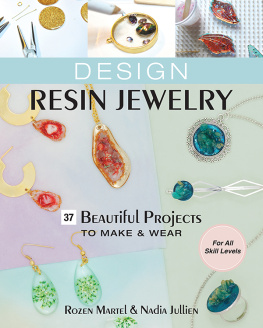

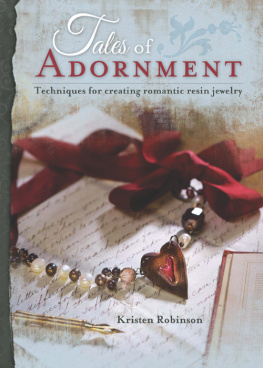
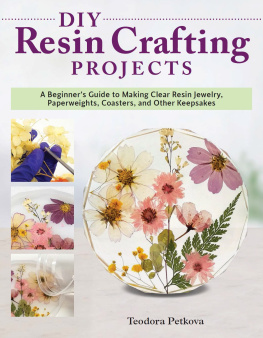
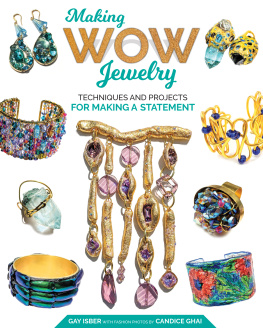
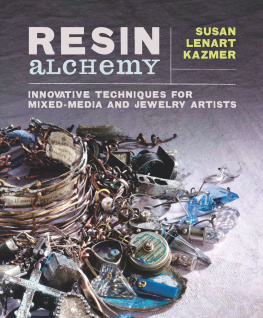
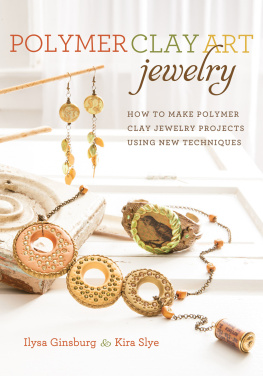
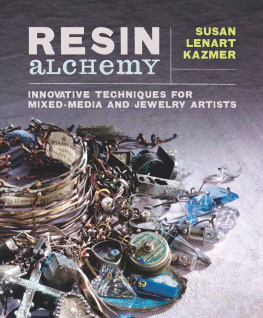
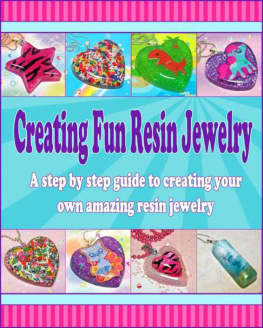
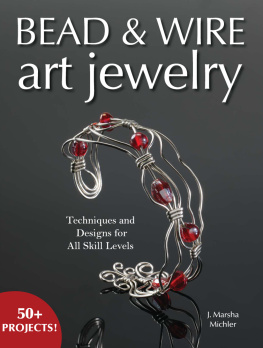
 Design Resin Jewelry First published in the United States in 2021 by Stash Books, an imprint of C&T Publishing, Inc., P.O. Box 1456, Lafayette, CA 94549 Rsine, 37 Bijoux Fantaisies 2019 by Editions Huapango / Un Dimanche Aprs-Midi. This translation of Rsine, 37 Bijoux Fantaisies, first published in France, is published by arrangement with Cat on a Book Agency, France. PUBLISHER: Amy Barrett-Daffin CREATIVE DIRECTOR: Gailen Runge ACQUISITIONS EDITOR: Roxane Cerda MANAGING EDITOR: Liz Aneloski ENGLISH-LANGUAGE COVER DESIGNER AND LAYOUT ARTIST: April Mostek ENGLISH TRANSLATION: Kristy Darling Finderi PRODUCTION COORDINATOR: Zinnia Heinzmann PRODUCTION EDITOR: Jennifer Warren GRAPHIC ELEMENTS PROVIDED BY SHUTTERSTOCK.COM: LyalyaBelaya ABOUT THE AUTHORSROZEN MARTEL-GOULIBO, aka Kerrozenn, is a creative jack-of-all-trades. This polymer addict, ever eager for new techniques and new means of expression, discovered resin and its fabulous possibilities in 2013. NADIA JULLIEN, aka Nadia Her, fell into crafting at a very young age. NADIA JULLIEN, aka Nadia Her, fell into crafting at a very young age.
Design Resin Jewelry First published in the United States in 2021 by Stash Books, an imprint of C&T Publishing, Inc., P.O. Box 1456, Lafayette, CA 94549 Rsine, 37 Bijoux Fantaisies 2019 by Editions Huapango / Un Dimanche Aprs-Midi. This translation of Rsine, 37 Bijoux Fantaisies, first published in France, is published by arrangement with Cat on a Book Agency, France. PUBLISHER: Amy Barrett-Daffin CREATIVE DIRECTOR: Gailen Runge ACQUISITIONS EDITOR: Roxane Cerda MANAGING EDITOR: Liz Aneloski ENGLISH-LANGUAGE COVER DESIGNER AND LAYOUT ARTIST: April Mostek ENGLISH TRANSLATION: Kristy Darling Finderi PRODUCTION COORDINATOR: Zinnia Heinzmann PRODUCTION EDITOR: Jennifer Warren GRAPHIC ELEMENTS PROVIDED BY SHUTTERSTOCK.COM: LyalyaBelaya ABOUT THE AUTHORSROZEN MARTEL-GOULIBO, aka Kerrozenn, is a creative jack-of-all-trades. This polymer addict, ever eager for new techniques and new means of expression, discovered resin and its fabulous possibilities in 2013. NADIA JULLIEN, aka Nadia Her, fell into crafting at a very young age. NADIA JULLIEN, aka Nadia Her, fell into crafting at a very young age.